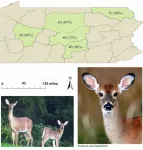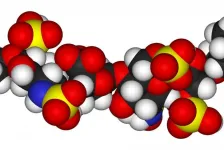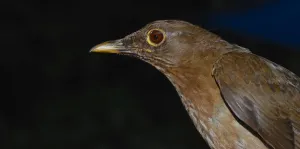(Press-News.org) Juvenile white-tailed deer that strike out to find new home ranges -- despite facing more risks -- survive at about the same rate as those that stay home, according to a team of researchers who conducted the first mortality study of male and female dispersal where deer were exposed to threats such as hunting throughout their entire range.
Dispersal occurs when a juvenile leaves the area where it was born and moves to a new location where the young animal establishes its adult home range, explained Duane Diefenbach, Penn State adjunct professor of wildlife ecology. The instinctual dispersal of young deer from the area where they were born to a new home range protects the species' gene pool from inbreeding with close relatives.
Diefenbach's research group in the College of Agricultural Sciences has radio-collared hundreds of Pennsylvania deer over the last 20 years, monitoring their survival, movement and behavior. Earlier research done by his lab, in collaboration with the Pennsylvania Game Commission, revealed that about three of every four young, male white-tailed deer disperse, with yearling female dispersal rates much lower.
Dispersal distances depend on forested cover, Diefenbach and colleagues demonstrated in previous research. But on average in Pennsylvania, males travel more than three miles, typically in direct, straight-line fashion; females that disperse often seemingly wander around before settling down an average of about nine miles from where they started.
"We wanted to know how risky dispersal is," said lead researcher Eric Long, now a professor of biology at Seattle Pacific University, who was a doctoral degree student at Penn State advised by Diefenbach when early stages of the research unfolded. He was surprised to find no detectable increase in death among dispersing deer.
"We expected to find that dispersal results in added mortality because deer are traveling across unfamiliar territory and are more likely to encounter predators or vehicles," Long said. "Going into this research, I expected to have a lot of our dispersers killed by vehicles as they were making the movement. We were surprised at how effective deer are at dispersing, especially when they have to deal with relatively modern risks like roads and hunting."
For this study, researchers captured 398 juvenile male and 276 juvenile female white-tailed deer and compared survival rates of dispersers and nondispersers.
Over three years, 381 males were equipped with very high frequency -- or VHF -- radio-transmitters and were located with telemetry at least weekly; 17 were equipped with global positioning system, or GPS, radio-transmitters that recorded positions at least twice daily. Over six years, 245 females were equipped with VHF transmitters and located at least weekly; 32 were equipped with GPS transmitters that recorded position at least daily.
Juvenile deer were captured in the winter through early spring. At the time of capture, they were seven to 10 months old. For both male and female white-tailed deer, natal dispersal prior to 11 months of age is rare, Long noted, so capture between December and April decreased the likelihood of capturing juveniles that had already dispersed.
Results of the research, recently published in Ecology and Evolution, indicate that for both male and female yearlings, survival rates of dispersers -- males 49.9%, females 64.0% -- did not differ appreciably from those of nondispersers -- males 51.6%, females 70.7%. Only two individuals, both female, were killed by vehicular collision during dispersal movement.
So, why do dispersing juvenile deer fare as well as nondispersers despite facing more risk? Researchers are not sure, but Long suspects that deer with the predisposition to be more adventurous might have a genetic makeup that helps them to avoid threats. Also, he said, there is some evidence to suggest that yearlings in better condition, with bigger bodies, are more likely to disperse than deer in poorer condition.
"It may be that only those deer that are up to the challenge of dispersal even try it," he said. "Bucks, which are more likely to disperse, seem much more efficient at dispersal than females. They don't mess around and wander all over the place like does -- and that likely decreases their risk."
INFORMATION:
Also involved in the research were Clayton Lutz, a master's degree student in wildlife and fisheries science who did his thesis on female deer dispersal and is now a biologist with the Pennsylvania Game Commission; and Bret Wallingford and Christopher Rosenberry, Bureau of Wildlife Management, Pennsylvania Game Commission.
The Pennsylvania Game Commission; Pennsylvania Audubon Society; the Susquehanna, Southeast and Northcentral Pennsylvania branches of the Quality Deer Management Association; the Pennsylvania Deer Association; and the U.S. Geological Survey supported this work. Diefenbach is an employee of the U.S. Geological Survey.
Researchers have identified a critical mechanism that allows deadly bacteria to gain resistance to antibiotics.
The findings offer a potential new drug target in the search for effective new antibiotics as we face the growing threat of antimicrobial resistance (AMR) and infections caused by bacterial pathogens.
The study investigated quinolone antibiotics which are used to treat a range of bacterial infections, including TB (tuberculosis). Quinolones work by inhibiting bacterial enzymes, gyrase and topoisomerase IV, thereby preventing DNA replication and RNA synthesis essential to growth.
They are ...
Spectacular fossil plants preserved within a volcanic ash fall in China have shed light on an evolutionary race 300 million years ago, which was eventually won by the seed-bearing plants that dominate so much of the Earth today.
New research into fossils found at the 'Pompeii of prehistoric plants', in Wuda, Inner Mongolia, reveals that the plants, called Noeggerathiales, were highly-evolved members of the lineage from which came seed plants.
Noeggerathiales were important peat-forming plants that lived around 325 to 251 million years ago. Understanding their relationships to other plant groups ...
TROY, N.Y. -- Using a nanopore, researchers have demonstrated the potential to reduce the time required for sequencing a glycosaminoglycan -- a class of long chain-linked sugar molecules as important to our biology as DNA -- from years to minutes.
As published this week in the Proceedings of the National Academies of Sciences, a team from Rensselaer Polytechnic Institute showed that machine-learning and image recognition software could be used to quickly and accurately identify sugar chains -- specifically, four synthetic heparan sulfates -- based on the electrical signals generated as they passed through a tiny hole in a crystal wafer.
"Glycosaminoglycans are a complex repertoire of sequences, ...
An international team of scientists have explained how legume trees are key in liberating minerals locked in iron minerals and the benefits are passed on to nearby trees
The research shows that the trees are able to alter their soils microbiome in a way that increases access to nutrients and supports growth
The findings provide new insight into the role of these trees in safeguarding the function of tropical forests and sustainable reforestation
Researchers have found that nitrogen-fixing legume trees can support themselves and surrounding trees not only with increased access to nitrogen, but with other key nutrients through enhanced mineral weathering.
The team, led by the University ...
In the United States, one in 10 babies are born too soon, resulting in complications that can affect their locomotor development and influence such simple tasks as balance, walking and standing later in life. A new peer-reviewed study by Children's National Hospital, published in the Proceedings of the National Academy of Sciences of the United States of America (PNAS), explores exactly what neural circuitry of the cerebellum is affected due to complications that occur around the time of birth causing these learning deficits, and finds a specific type of neurons -- Purkinje cells -- to play a central role.
Up until now, there has been a sparsity of techniques available to measure neuronal ...
American adults without a college degree have experienced greater reductions in life expectancy when compared to their more-educated counterparts, USC and Princeton researchers have found.
The study reveals that after nearly a century of declining mortality up to the late 1990s, the progress continued into the 21st century for more-educated Americans but stalled for the population as a whole and reversed for the two-thirds of Americans who do not have a college degree.
The study appeared Monday in the Proceedings of the National Academy of Sciences.
The ...
Malaria is the deadliest pathogen in human history. Nearly half the people on Earth are at risk of contracting the disease from the parasites that cause it. But humans aren't the only ones who can get these parasites--different forms are found in other animals, including birds. By studying the DNA of those strains, scientists can get a better picture of how malarial parasites live, which may give clues on how to stop the disease. In a new paper in PNAS, researchers analyzed blood samples of more than 1,000 species of birds from the Andes looking for malaria; they found that the strains of malaria present in a local area don't always neatly align with the types of birds living there.
"Traditionally, we thought that there's ...
(Boston)--Despite the positive advances that anti-human immunodeficiency virus (HIV) therapy, commonly called anti-retroviral therapy (ART) or highly active antiretroviral therapy (HAART), has had on the life expectancy of HIV-positive people, finding a cure for HIV or acquired immunodeficiency syndrome (AIDS) has remained elusive.
"One of the major challenges in curing HIV is that there is a persistent latent reservoir of virus that is not targeted by current antiretroviral treatments and is hidden from immune cells. When treatment is interrupted, this reservoir of the virus allows the HIV ...
Here is a link to a free Altmetric Report on this Research Output
Aging-US published "Hyperbaric oxygen therapy increases telomere length and decreases immunosenescence in isolated blood cells: a prospective trial" which reported that the aim of the current study was to evaluate whether hyperbaric oxygen therapy (HBOT) affects telomere length (TL) and senescent cell concentrations in a normal, non-pathological, aging adult population.
Thirty-five healthy independently living adults, aged 64 and older, were enrolled to receive 60 daily HBOT exposures.
Whole blood samples were collected at baseline, at the 30th and 60th session, and 1-2 weeks following the last HBOT session.
Telomeres length of T helper, T cytotoxic, natural killer and ...
CHAMPAIGN, Ill. -- Tiny fluorescent semiconductor dots, called quantum dots, are useful in a variety of health and electronic technologies but are made of toxic, expensive metals. Nontoxic and economic carbon-based dots are easy to produce, but they emit less light. A new study that uses ultrafast nanometric imaging found good and bad emitters among populations of carbon dots. This observation suggests that by selecting only super-emitters, carbon nanodots can be purified to replace toxic metal quantum dots in many applications, the researchers said.
The findings, published in the Proceedings of the National Academy of Sciences, ...





